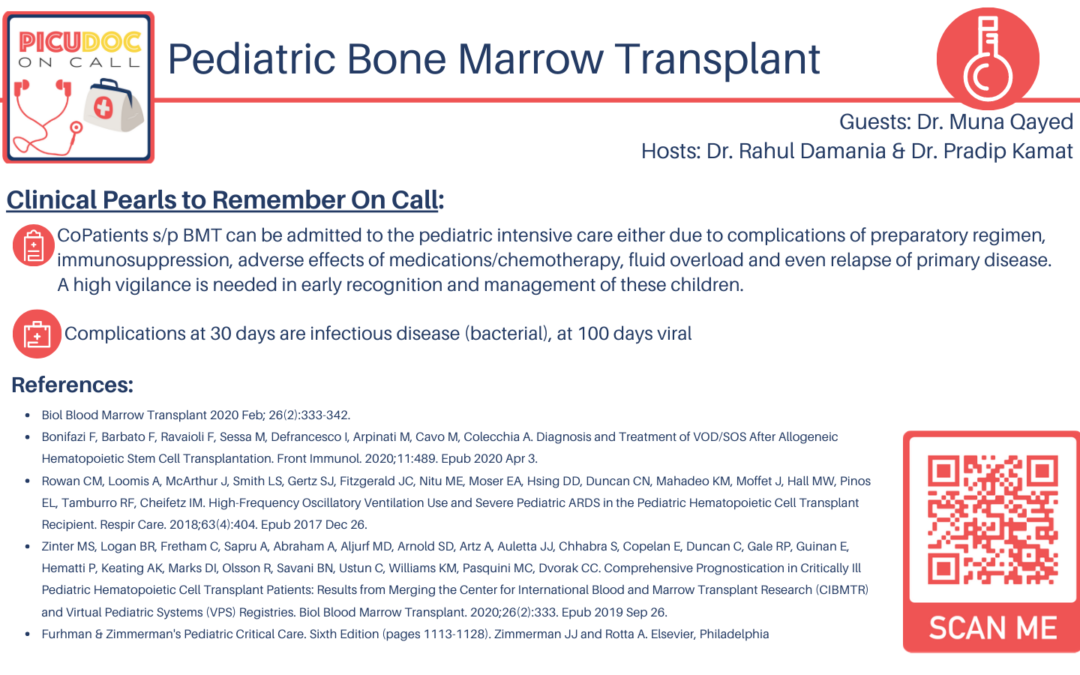Today’s episode is dedicated to Critical Illness In Children With Hematopoietic Stem Cell Transplants.
We are delighted to be joined by Dr. Muna Qayed, Associate Professor of Pediatrics Emory University School of Medicine , Atlanta, GA. She is also the Director of the Blood and Marrow Transplant Program at the Aflac Cancer and Blood Disorders Center at Children’s Healthcare of Atlanta.
Our Case: A 10 year old female with refractory high-risk ALL s/p mismatched unrelated donor transplantation T+13 days presents as a transfer to the PICU with abdominal distention, worsening jaundice, and escalating nasal cannula requirements. The patient’s post-transplant course was complicated by gram-negative bacteremia requiring fluid resuscitation. A CXR upon transfer to the PICU is notable for bilateral airspace disease, a right sided pleural effusion, and hypoexpanded lung fields. The patient is promptly intubated, sedated and started on renal replacement therapy. Echo labs, and further imaging are pending.
What are the classic pediatric indications for BMT?
- Autologous BMT (where donor cells are from the patient/recipient) is used as consolidation in some solid tumors such as High risk neuroblastoma, brain tumors like medulloblastoma, and germ cell tumors, and are a standard treatment approach in relapsed Hodgkin lymphoma
- Allogeneic BMT-where in the donor cells are derived from another individual are typically used for hematologic malignancies. ALL and AML are most common pediatric indications.
- Also allogeneic BMT are used for wide spectrum of nonmalignant hematology conditions such as hemoglobinopathies ( Sickle cell disease, Thalassemia), and severe aplastic anemia, and inherited bone marrow failure syndromes, as well as some metabolic disorders and immune-deficiency disorders such as SCID, HLH and other primary immune regulatory disorders.
The sources of graft in BMT?
- Stem cells (which give rise to different types of blood cells – red cells, white cells and platelets are derived from the bone marrow. Thus the overall process is known as Bone Marrow Transplantation.
- Stem cells can be also derived from peripheral blood – when the donor is treated with granulocyte colony stimulating factor or G-CSF.
- There are some key advantages here, which include the ability to collect a much higher stem cell dose, with faster hematopoietic recovery.
- However the downside is a higher T cell content of the graft with subsequent increased risk of graft versus host disease.
- Umbilical cord blood is also used as a source of stem cells.
- Mega doses of stem cells are used to overcome histocompatibility barriers of mismatched transplantation. Majority of T cells have to be removed from donor pool to prevent severe GVHD., Increase risk of infection and relapse of patients original disease.
Explain the human leucocyte antigen (HLA) and its role in BMT?
- The Major Histocompatibility complex (MHC) system known as the human leukocyte antigen (HLA) in humans is located on the short arm of chromosome 6 and contains the most polymorphic gene cluster of the entire human genome.
- The HLA consists of regions designated as “classes”. Class I and class II are relevant to stem cell transplant.
- The main function of HLA class I gene products (HLA-A, -B, and -C) is to present endogenous peptides to responding CD8+ T Cells, HLA class I antigens are expressed on all nucleated cells and platelets.
- While the class II coded molecules HLA-DR, -DP, and –DQ have restricted expression and process exogenous peptides for presentation to CD4+ helper T Cells, and are expressed on antigen presenting cells. HLA-A, HLA-B, HLA-C and HLA-DR are traditionally the loci critical for matching for stem cell donor.
- In addition to deciding on the source of the graft, we have to make decisions on who the donor will be. If a matched sibling donor is not available (or in some inherited conditions that may not be an option as a donor), then matched unrelated donors or matched cord blood units of appropriate size can provide a good option to proceed.
- Then come considerations of mismatched unrelated donors, and haplo-identical related donors.
- The type of donor and degree of match dictates the type of GVHD prophylaxis we will use and further immunosuppression.

